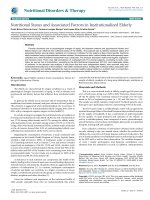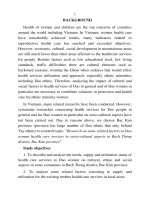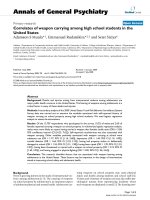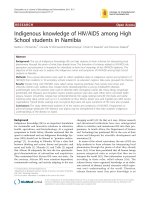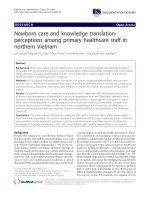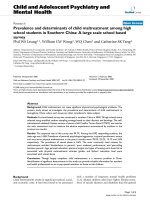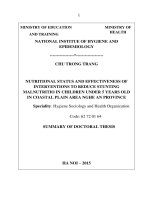Nutritional status and some related factors among primary school children in Thai Nguyen and Nghe An provinces in 2020
Bạn đang xem bản rút gọn của tài liệu. Xem và tải ngay bản đầy đủ của tài liệu tại đây (531.96 KB, 80 trang )
1
MINISTRY OF
MINISTRY OF HEALTH
EDUCATION .AND TRAINING
HANOI MEDICAL UNIVERSITY
NGUYEN THI PHUONG ANH
NUTRITIONAL STATUS AND SOME RELATED FACTORS
AMONG PRIM ARY SC HOOL CHILDREN
IN THAI NGUYEN AND NGHE AN PROVINCES IN 2020
Specialization: Doctor of Preventive Medicine
Code: D720302
THESIS OF GRADUATION MEDICAL DOC TOR
COURSE 2015-2021
Mentors'. 1. Assoc.Prof.PhD. Pham Van Phu
2. Assoc.Prof.PhD. Tran Thuv Nga
HANOI-2021
-■c -ÍM Qỉ ugc V
Hl
ãĩi
CONTENTS
1.3.1. Eating habits............................................................................................. 11
1.3.2.
Physical activities
1.3.3.
Socio-economic factors.............................. ............................... ..........13
12
CHAPTER 2: RESE.ARCH SUBJECTS AND METHODOLOGY.......................... 16
2.1....................................................S
„............................................................ 16
2.2.....................................................................S
tudy location
Subjects..............................
tudy
and study time......................
2.3.
Research
Methodology
2.3.1. Study design.............................................................................................. 16
r-u -ÍM Qỉ ugc V
Hl
3
RECOM MENDATION........................
REFERE NCES
2.3.2 The sample size and sampling method
16
Sample size
16
2.3.3. Variablesand indicators
17
2.3.4. Data collection
18
2.5. Potential Errors and Solutions
....20
2.6. Data management and analysis
2.7. Ethical issues
20
.21
CHAPTE R 3: R ESU LTS
22
3.1. Characteristics of research subjects
22
3.2. Nutritional status of students
26
33. Some factors related to nutritional status of students
29
CHAPTE R 4: DISCUSSION
4.1. Nutritional status of students....................................
4.2. Some related factors to the nutritional status of students................................. 42
4.2.1..............................................................................Socio-demographv factors
42
4.2.2.....................................................................................Environmental factors
47
4.2.3........................................................................................Eating habits factors
CONCLUSION................................
ABBRE MATION
BMI
Body Mass Index
FAO
Food and Agriculture Organization
UNICEF
United Nations Children’s Emergency Fund
WHO
World Health Organization
NCHS
National Center for Health Statistics
r-u -ÍM CỊỈ ugc V
Hl
•■•••••a
53
4
SD
Standard deviations
BAZ
BMI-for-Age z-score
HAZ
MUAC
Height-for-Age z-score
Mid-Upper-Arm c ircumference
X'ND
Vietnamese Dong
LIST OF TABLES
LIST OF FIGURES
r-u -ÍM CỊỈ ugc V
Hl
ACKNOWLEDGEM ENT
First and foremost, I would like to express my deep sense of gratitude and appreciation
towards Assoc Prof. Pham Van Phu from the Department of Nutrition and Food Safety,
Institute for Preventive Medicine and Public Health for his invaluable guidance,
constant encouragement, expert suggestions, constnictive criticism, and supervision
which was most crucial in completing this thesis work
I am extremely grateful to Assoc Prof Tran Thuy Nga. head of Department of
Micronutrient Research and Application. National Institute of Nutrition, for her keen
interest, guidance, supervision, and valuable advice for thesis improvement
I would like to express my deep thanks to the Managing Board. Department of
Training, Hanoi Medical University who had created a welcoming and wonderful
environment in the school for the past six years I wish to thank all the teachers in the
Department of Nutrition. Institute for Preventive Medicine and Public Health. Hanoi
Medical University for their valuable information provided by them in their respective
fields. I am grateful for their cooperation during the period of my assignment
Finally, I want to express my gratitude to my wonderful family and friends who have
stood by my side throughout this ordeal. Your unwavering love and unwavering support
inspired me to keep going
Student
Nguyen Thi Ph uong Anh
6
COMMITMENT
To:
-
Management Board of Hanoi Medical University.
-
Department of Undergraduate Training Management and Department of Student
Affairs. Hanoi Medical University
-
Institute for Preventive Medicine and Public Health. Hanoi Medical University.
-
Department of Nutrition and Food Safety. Hanoi Medical University.
-
Examination Committee for Graduation Thesis 2020-2021
I hereby declare that I am the author of this research The data collection and analysis
were carried out objectively and truthfully. These findings in this study have yet to be
published.
May 202 1 in Hanoi Student Nguyen Thi Ph uong Anh
r-u -ÍM CỊỈ ugc V
Hl
7
ABSTRACT
Background & Objectives: A cross-sectional study was conducted with the objectives to
describe the nutritional status of primary school children (7-10 years) in Thai Nguyen
and Nghe An provinces: to analyze some related factors to the nutritional status of
students.
Methods: The study period was from November 2020 to December 2020. A total of 262
students from two provinces comprise the study population Probability proportional to
size sampling method was used. Data entry and statistical analysis were performed with
the help of STATA version 15.0 Height-for-Age Z-score (HAZ) and BMI-for-Age Zscore (BAZ) were calculated using WHO Anthroplus Software and using WHO
Reference 2007 values
Results: The prevalence of overweight and obesity was 25.6% (in which overweight
was 16.8%. obesity was 8.8%). The prevalence of stunting was 8.0% and wasting was
6.5%. Some factors related to the nutritional status of primary school students were
BMI of parents, education level of parents, the care of mother; family size (>5 people):
total household income: habit of drinking soft drinks, eating instant noodles, eating
outside the home, eating at fast-food restaurants
Interpretation & Conclusion: The present study showed the prevalence of malnutrition
was relatively high. Socioeconomic factors, parental factors and eating habits were
associated with the nutritional status of students. Prompt integrated efforts should be
made to improve the nutritional status of primary school students.
Keywords: nutritional
malnutrition,
primary status,
school children.
related factors
Thai Nguyen.
to
Nghe
An.
-ÍM CỊỈ ugc V
Hl
8
INTRODUCTION
Malnutrition has been a global public health problem In 2019 : there still were
144 million children under 5 with stunting and almost 50 million with wasting; at the
same time, overweight and obesity in chi Idren and young people were continuing to
rise [1] In Vietnam the stuntingrate for children under 5 was 19 6% in 2020. meaning
that one out of every five Vietnamese children under the age of five was stunted The
rate of stunting malnutrition among school children (5-19 years old) was 14.8% in 2020
(this rate was 23.4% in 2010) [2] On the other hand, overweight and obesity had
increased rapidly. National Institute of Nutrition research during 2017- 2018 revealed
the overweight obesity rate of 5.000 sampled school children in a variety of provinces
was 29% [3]
Every’ country in the world has been affected by one or more forms of
malnutrition and should consider combating these as one of the greatest global health
challenges Socio-economic determinants such as income, ethnicity, geographical
location, and intra-household parental factors could be related to a child's nutrition level
When children's nutritional status deteriorated, a vicious cycle of chronic disease and
growth failure developed As a result, having a comprehensive understanding of
children's nutritional status had far-reaching consequences for future generations'
wellbeing [4].
The primary school years were the time of rapid physical and mental
developirent Low school attendance, high absenteeism, early dropout and unsatisfactory
classroom performance had all been related to poor nuưitional status (5] [6], Children
who were well-fed did well in school andreached their full physical and mental capacity
Malnutrition was an associated cause in about half of all deaths occurring among
children in developing counưies and also slowed economic growth and perpetuated
poverty [7] According to estimates, malnutrition in all types could cost society up to 3.5
ưillion dollars each year, with overweight and obesity costing 500 billion dollars [8],
Many studies have been conducted worldwide on the nutritional status of
children of all ages Studies done in rural and utban areas in different parts of Vietnam
r-u -ÍM
-ÍM Qỉ
Qỉ ugc
ugc V
V
Hl Hl
9
have reported a high prevalence of malnutrition among children but most of these
focused on the age under five [9] [10][12] There has been a paucity of information
based on nutritional status in primary schools from the northern and centra 1 provinces
of Vietnam. In order to provide more data to improving many nutrition-related
problems, research named "Nutritional status and some related factors among primary
school children in Thai Nguyen and Nghe An provinces in 2020" was conducted with
two specific aims:
1 To describe the nutritional status of primary’ school children in Thai Nguyen and
Nghe An provinces in 2020
2. ToAn
status
analyse
among
primary
somein
factors
schoolrelated
children
toin
the
Thai
nuưitional
Nguyen and
Nghe
provinces
2020
-ÍM Qỉ ugc V
Hl
CHAPTER 1: LITERATURE REVIEW
1.1 Nutritional status and some methods of assessment of the nutritional status
1.1.1.
Definition of nutritional status
Nutritional status refers to an individual's physiological state as a result of the
interaction between nutrient intake and needs, as well as the body's ability to digest,
absorb, and utilize these nutrients. When the human body absorbs all of the nutrients in
adequate quantities to satisfy its needs Jn a state of good nutrition, which implies
normal nutritional status However, when the nutrients in the diet are insufficient or are
not adequately used, the body becomes unbalanced. If this persists for an extended
period of time it could become a serious issue peihaps fatal [12] A state of imbalance in
die body occurs when there is a deficiency or excess intake of one or more nutrients, as
well as faulty nutrient utilization Malnutrition or a poor nutritional state, is the term for
this condition. Malnutrition can be classified into two groups Undemutrition is a
disorder in which a person's wellbeing suffers as a consequence of a lack of one or
more nutrients. Overnutrition. on the other hand, occurs when nutrients areconsumed in
abundance [13]
1.1.2.
Brief reviews about methods of assessment of the nutritional status
Nutritional status assessment can be defined as the process of the collection and
analysis of information and data on nutritional status and assessing the situation on the
basis of such information and data [14]
1.1.2.1.
Anthropometric methods
Anthropometry is the measurement of the size weight, and proportions of the body.
Common anthropometric measurements include weight, height mid-upper arm
circumference, skin fold thickness, head and chest cucumferences. and calculation of
theZ scores of appropriate indices. It is frequently used to assess nutritional status as
well as growth and development of school-aged children and adolescents. As a public
health tool anthropometric measurements have been widely used for the assessment of
the nutritional status of both children and adults This has also been underlined by
Jelliffe who described its use in the nutritional assessment as "measurements of the
variations of the physical dimensions and the gross composition of the human body at
different age levels and degrees of nutrition'' [15]. At the level of the individual child,
anthropometry is not only useful for detecting those who are at risk of malnutrition, and
for the selection of affected children for nutritional intervention programs but also
useful for assessing the effectiveness of such programs [ 16].
In the community, anthropometry is usefill in the determination of the prevalence of
malnutrition Although anthropometric methods can be relatively insensitive to short
term nutritional status, these are precise and accurate, provided standardized techniques
are utilized The procedures are simple, safe and non-invasive. The equipment required
is inexpensive, portable, durable, and can be made or purchased locally. In addition,
relatively unskilled personnel can perform measurement procedures. The information
generated is based on past nutritional history and can be used to monitor and evaluate
changes in nutritional status over time. Anthropometry can also be used to quantify- the
degree of nutrition and provide a continuum of assessment from under to over-nutrition
It permits the stratification of survey results according to age. sex. region, niral urban,
or ođier sociodemographic characteristics of the population [17], Hence, it aids in
providing more information for detecting vulnerable groups and for a better
understanding of the situation
Heights and weights of children are accepted as measures for monitoring their growth
and nutritional status. They are also considered as indicators of the nutritional status of
the entire community. The indicators used for classification by comparison with a
reference population include weight-for-height (\v H). weight-for-age (W A), heightfor-age (H A). Body Mass Index (BMI) for age Although they are by no means the only
ones that have been used they are the most commonly used anthropometric indicators
for children
Weight-for-age (W A) reflects body mass relative to age Extreme cases of low w A
relative to children of the same se.x and age in the reference population are commonly
referred lo as “underweight*' [18] Underweight is defined as low weight for age below
2 standard deviations (SD) of the median value of the National Center for Health
Statistics (NCHS) WHO international growth reference w A is frequently used to track
growth and evaluate changes in the magnitude of malnufrition over time [16] [IS]
However, w A is a composite measure of height-for-age and weight-for- height, making
interpretation difficult in the effects of short- and long-term health and nutrition
problems.
Height-for-age The ratio (H A) denotes cumulative linear growth H A deficits indicate
past ŨĨ chronic nutritional deficiencies, as well as chronic or frequent illness, but they
are unable to detect short-term changes in malnutrition [15] [19] Extreme cases of low
H A relative to children of the same sex and age in the reference population arc referred
to as "stunting", which is an index of chronic malnutrition. Stunting is defined as low
height for age which is below 2SD of the median value of the NCHS WHO
international growth reference [16]. HA is primarily used as a population indicator
rather than for monitoring individual growth n’eight-for-height (w H) is a method of
determining body weight in relation to height that does not require age information w H
is typically used as a measure of cunent nutritional status and can be useful for
identifying at-risk children as well as tracking short-term changes in nutritional status
[20] Extreme cases of low w H are commonly referred to as "wasting." Wasting is
defined as having a low' weight for height that is less than two standard deviations
belowthe NCHS WHO international weight for height reference [16). It may be the
consequence of starvation, chronic conditions, or severe diseases such as dianhea
Bodybe
weight
mass
in
index
kilograms
.is
The
byBMI
the
square
calculated
height
dividing
into
meters
BNÍ1
can
good
indicator
used
to of
determine
body
fat
ais
Child
levels.
sof
weight
It
isby
used
status
andthe
determine
is
a
whether
a person
underweight overweight, or at risk of becoming overweight The weight for height chart
does not reflect age-related changes, whereas the BMI for age chart does. Obesity is
defined as a BMI of greater than *2 z scores forage Overweight is defined as a BMI of1 to ~2 z scores forage [13],
Anthropometric indices are created by comparing relevant measures to those of
comparable individuals (in terms of age and sex) in reference populations, regardless of
the reference data used. There are several ways to express these comparisons; one is the
z-score (standard deviation score), which is defined as the difference between an
individual's value and the median value of the reference population for the same sex
and age (or height) divided by the reference population's standard deviation (21).
1.1.2.2.
Other methods
Nutritional status can also be assessed by the following methods (19):
Biochemical assessment The test levels of nutrients in a person’s blood, urine, or stools
are known as biochemical evaluation Laboratory findings may provide qualified
medical practitioners with important information about medical conditions that can
influence nutritional status.
Clinical assessment . Looking for or asking about signs of illness that may increase
nutritional requirements (e g., fever) and nutrient loss (eg., diarrhea and vomiting), as
well as medical conditions (e g.. HIV, celiac disease) that hinder digestion and nutrient
absorption and increase the likelihood of malnutrition, are both part of a clinical
nutrition evaluation
Dietan- assessment: The measurement of food and fluid intake is an important part of
the nutrition assessment process It prorides details on dietary quantity and consistency,
appetite changes, food allergies and intolerance, and explanations for insufficient food
intake during or after illness.
1.2.
Previous studies on the nut ritional status of children
1.2.1.
In the world
Malnutrition in all of its forms, has continued to be unacceptably high in all parts of the
globe Despite progress. 144 million children under the age of five were stunted (213%),
47 million children under five years were wasted [1] , and 20 million newborn babies
were estimated to be underweight [22] . while 383 million children under under five
years of age were overweight [1].
Stunting affected a large proportion of children in many countries, with around 35% of
primary school children in Northern Bangladesh [23], 40% in Southeast Nigeria [24]
and 3S.8% in Northern Sumatera. Indonesia [25], Despite a decrease in the prevalence
of stunting in Africa, the number of stunted children in the continent had steadily
increased from 49.7 million in 2000 to 57.5 million in 2019. South Asia had the highest
burden of stunted children in the world, accounting for 38.8% of all stunted children
worldwide [1] Wasting and stunting were linked to an increased risk of death, especially
when they occured in the same child (26).
In 2013. wasting was responsible for around 13% of all deaths among children under
the age of five worldwide, resulting in 875,000 child deaths that could have been
avoided [27]. South Asia has been also a global hotspot for wasting, with 15.2% of
under-5s affected, a proportion classified as "high" by international agencies (28) Not
only that children with severe acute malnutrition were nearly 12 times more likely than
healthy children to die if they were not treated [29] Severe wasting has been still
prevalent around the world, with an estimated 14 3 million children under the age of
five suffering from it in 2019 [30]
Obesity, as well as being overweight, should be taken into account. Obese girls and
boys between the ages of 5 and 19 had increased 10- to 12-fold globally since the mid1970s [31] Nearly half of the world’s overweight under-5s lived in Asia in 2018. and a
fifth in Africa [1]. Malaysia had a severe double burden of malnutrition: 20 7 percent 0
f children under the age of five were stunted, and 11.5% were wasting while 15.7% of
children (5-9 years old) were obese [32] [33] In poor urban areas, where malnutrition
rates were higher than the national average, the situation was even more complicated
(34] China had seen a remarkable shift in malnutrition as a result of rapid economic
growth and urbanization Although the rate of stunting among schoolchildren decreased
from 16% in 1985 to 2% in 2014. the rate of overweight and obesity rose from 1% to
20% (35].
Overweight and obese children accounted for more than 40% of North American and
Mediterranean children. 38% of European children. 27% of Western Pacific children,
and 22% of Asian children [36] In Argentina, a study of 1.5S8 children aged 10-11
years from 80 public schools in Buenos Aires found that 35.5 percent of the children
were overweight or obese [37] By the time they finished primary school one in three
children in England had been overweight or obese [38] The prevalence of overweight
and obesity was 26% in the Alice Goisis study of 9384 11 -year-olds in the UK [39],
Southeast Asia was one of the regions that was suffering from a double nutritional
burden [40], while the prevalence of malnutrition remained high, the rate of overweight
and obesity continued to rise, particularly among school-aged children in ASEAN
countries. The rate of overweight and obesity in ASEAN countries was 9.9%. with men
(11 5%) outnumbering women (8.3%). Brunei had the highest rate of overweight and
obesity (36.1%), followed by Malaysia (23.7%). the lowest was Myanmar (3.4%) and
Cambodia (3.7%) [41] According to other studies conducted in Indonesia the obesity
rate among children aged 6 to 12 years was 11.5% [42], and the rate of overweight
among school-aged children was extremely high (20.4%) [43]
1.2.2.
In Vietnam
Unlike several other countries in the region. Vietnam has seen a substantial reduction in
child malnutrition. Stunting among children under the age of five had gradually
decreased, from 56.5% in 1990 to 36.5% in 2000. a record dropped of nearly 20% in a
decade. In 2010. the figure was 29.3%. and in 2020, it was 19.6%. According to WHO
appraisal criteria, this was a medium degree [2] [44]. Malnutrition prevalence varied
significantly across ecological regions. In general, the rate of malnourished children
under the age of five in the South was lower than in other regions (the rate of stunting
in the Mekong Delta was 28.2% in 2010 and 23.5% in 2015; the rates of underweight
were 16 8% and 12 2 %. respectively), indicating that the stunting rate in this area was
still ver}’ high [45] [46]
The prevalence of malnourished children aged 6-10 years old was 26 6% in 2000,
according to the National Nutrition Institute, with rural areas having a higher rate than
urban areas (282% compared to 19 6%) [47] In 2006. the stunting rate for students aged
6-8 years at Yen Thuong Primary School in Gia Lam, Hanoi, was 14.1% [48], according
to Nguyen Thi Mai Anh In 2007. die stunting rate of students aged 6-8 in Hanoi's Soc
Son district was 2S% [49], according to Ho Thu Mai et al According to the National
Institute of Nutrition's Nutrition Survey 2009-2010. 23 .4% of children aged 5-10 years
old were stunted (male27.5% and female 19.5%) [50]. Stuntingrates of high school
students in urban, agricultural, and mountainous areas in the three northern provinces
were 6.1%. 20.7%. and 23.9%. respectively, according to Le Thi Hop and Le Nguyen
Bao Khanh in 2012 [51] In 2017, a cross-sectional analysis of 750 children aged 6-10
years old in 3 communes. Van Giang district, Hung Yen province revealed that the
prevalence of underweight stunting, and wasting in die study children was 6.8%. 5 9%,
and 11.3%, respectively [52], According to Nguyen Song Tu et al's 2017 survey, the
stunting rate of 7-10 year old primary school students in 5 communes of Phu Binh
county, Thai Nguyen province was 17.2%. the underweight rate was 24.5%, and the
wasting rate was 7.9% [53],
Vietnam was among a group of 20 countries with the highest number of stunted
children in the world, as well as some countries, especially in Southeast Asia, where the
nutritional burden was doubled Although stunting was still prevalent, the number of
overweight and obese people was rapidly rising, especial!}- in urban areas [54], Until
2000. there was almost no overweight or obesity in children under the age of five; but.
over the next ten years (2000-2010) this prevalence had tripled in adults and increased
by nine times in children under the age of five (from 0.6S% to 5.6%) [55]
The rate and rate of increase overweight and obesity among primary scho-ol students
varied by area, particularly in large cities and cities with centralized government
controL The prevalence of overweight and obesity among children aged 5-19 years in
the Red River Delta area was 9%. 13.4% in the Central region, and 23.3 % in the
Southeast according to the 2010 National Census [55]
Ho Chi Minh City had the high rates of overweight and obesity in the country, as well
as an alarming increase in overweight and obesity among pre-school and school
children, particularly in the inner city and among children of preschool age (54.5% in
Ho Thi Ky inner-city primary school and 31 2% in Phu Hoa Dong suburban primary
school) (56]. After a six-year period (2002-2008). the incidence of overweight and
obesity among primary school students in District 10 rose by more than three times
(9.4% and 28.5%) [57], reaching 41.4% in 2014 (19% are obese) (58). Haiphong city
also had a high prevalence of overweight and obesity. The rate of overweight and
obesity for students aged 6-11 in Hong Bang district was 10 4% in 2000, 31.3% in
2012, and 50.4%in2014 [59].
In Hanoi, a major city the prevalence of overweight and obesity among people of all
ages was gradually growing with 41.7 % of primary school students becoming
overweight or obese in 2017 and 44.7% in 2018 [60].
Overweight
school
students
and
obesity
in
noncentral
were
less
cities
common
than
among
in
central
primary
cities
region
This
(Buon
rate
Ma
Thuot
was
6.1%
was
in
9.1%.
four
PleiKu
cities
was
in
7.8%.
Tay
Nguyen
Gia Nghia
town
and
city
Kon
Turn
was
3.6%)
[61].
18
1.3. Some factors associated with the nutritional condition of children
The nutritional needs and diet-related behaviors of children developed and changed
throughout childhood, from the womb to adulthood Week by week, an infant's
physiological state had changed dramatically. Children’s eatinghabits and diets could
drastically change once they started school The nutritional status of children was
influenced by changes in what they consumed, decreased physical activity, and
socioeconomic conditions [62].
Ỉ.3.Ỉ. Eating habits
Far too many school-aged children around the world consumed insufficient amounts of
fruits and vegetables and consumed far too many unhealthy snacks high in sugar,
saturated mt, sodium, and salts, such as bread, cookies, sweets, ice cream and
sweetened beverages frequently marketed to and popular among school-age children
(63]. No children aged 7 8 years met the diet quality index for vegetables in a Brazilian
study [64]. Children in developing countries,particularly those from poorer families and
in rural areas, had diets that consisted primarily of a few staples such as cereals, roots,
and tubers, with little protein [65]
Breakfast patterns should be taken into consideration as well. Despite the strong
evidence of its benefits many school-aged children lacked or delayed breakfast around
the world, depriving them of a meal that was especially beneficial to cognition
especially among undernourished children (66) Children who delayed or postpone-d
breakfast had a higher BMI than their peers in certain environments According to a
2007 study conducted in New Zealand, children who skipped breakfast consumed more
snacks between meals, such as chocolate, cakes, chips, or crisps and sweetened
carbonated beverages that were rich in calories but low in nutrients [67].
Al-Domi, HA, et al found that students who ate a regular meal and snacks from school
cafeterias were risk factors for overweight and obesity in 977 students (473 males and
449 females) aged 7-18 years old in three major cities in Jordan (Amman. Irbid. and
-■c-ÍM
-ÍM Qỉ
Qỉ ugc
ugcV
V
Hl Hl
19
Mafraq) [68]. According to Tran Thi Xuan Ngoc’s research, there was a connection
between eating patterns and the state of disorder (gluttony and junk food) [69].
Consumption of thermogenic nutrients, soft beverages, and foods high in sugar bile,
parental care practices of children, or families that did not regulate their sugary sweet
food intake were all factors that raised the risk of overweight and obesity, according to
another report by Le Thi Hop et al (70]. Sugary snacks, which failed to provide children
with the nutrients they needed for healthy growth while providing excess calories to the
mother, were being blamed by Egyptian researchers [71].
1.3.2.
Physical activities
The American Physical Activity Advisors- and Guidance Committee recommended in
2008 that children under the age of 18 devoted 60 minutes a day engaging in mild to
extreme physical activity in order to decrease the prevalence of overweight and obesity
[72].
However, only 48.9% of bos’s and 34.7% of girls aged 6 to 11 had access to these
physical activity recommendations Physical activity time decreased by around 37.6
minutes a year between the ages of 9 and 15. according to longitudinal studies, with just
11 9% of boys and 3 .4% of girls in the 12-15 age group knowing the physical activity
guidelines [73]. Sedentary habits as well as die exercise of fewer than 30 minutes a day,
were risk factors for overweight and obesity, according to a study conducted by AlDomi HA et al on 977 students aged 7 to 18 years in three major cities in Jordan [68]
Blanco et al. found that children with obesity were less physically active than children
of normal weight in a study comparing the physical activity levels of 50 children with
obesity aged 8-12 years to children of normal weight [74], According to a study
conducted by Nguyen Minh Phuong et al on more than 1,000 students in Can Tho,
stunted children accounted for 9.8% of those who participated in physical activity or
sports which was lower than the community who did not exercise or participate in
sports (25.4%) (75).
13.3. Socio-economic factors
-ÍM Qỉ ugc V
Hl
20
The most critical causes for malnutrition, according to several reports, were the
economic and social conditions.
There was no question that a family's income had a significant impact on a childầ health
and nutrition. Children from low-income households were more likely to be
overweight. Overweight in children declined as families’ education and income levels
grew in the United States, for example [76]. In Europe, a correlation between obesity
and socioeconomic deprivation had been identified Obesity was related to parental
socioeconomic status and lack of education in children in Czechia Portugal and Sweden
according to a report based on data from the WHO Childhood Obesity Surveillance
Initiative in Europe in 2008 [77]
Geographic
to
obtain
essential
isolation
foods,
could
also
as
well
affect
as
healthcare
ahealth
family's
and
ability
nutrition
as
many
stunted
sen
ices.
children
Burundi.
as
metropolitan
Honduras,
and
counteiparts,
Mali
had
twice
and
Peru
were
had
still
three
more
times
common
as
many
wealthier
[1]
Obesity
families
and
overweight
[78],
and
concentrations
schoolchildren
were
in
urban
substantially
areas
though
higher
the
among
gap
was
narrowing
and
living
had
in
even
urban
converged
areas
had
in
some
been
affluent
found
to
areas.
be
taller
Children
than
other
peers
socioeconomic
of
the
same
factors.
generation
Bharati
[79],
et
al
In
discovered
addition
to
that
the
impact
divide,
of
spatial
was
important
disparity,
in
terms
especially
of
the
status
rural
[80]
Urban
their
children,
rural
counterparts,
regardless
according
of
gender,
to
were
Ghosh,
more
due
obese
to
an
than
urban
lifestyle
and
lack
of
physical
activity
[81],
-■c-ÍM
-ÍM Qỉ
Qỉ ugc
ugcV
V
Hl Hl
21
In the United States, researchers examined the effects of race and ethnicity on dietary
consumption Malnutrition was described as being overweight in this study Children
with African ancestry had a higher risk of being overweight than other children
according to studies Furthermore. African girls were 6% to 7% more likely than
Mexican-American boys to be overweight [82]
According to Mohseni et al. socioeconomic factors such as gender, father’s occupation,
and mother's education level had a major impact on children's nutrition in Iran [83],
Age. gender mother's BMI mother's educational status, father's educational status place
of residence, socioeconomic status community status religion, and region of residence
were all significant factors in childhood malnutrition according to a 2016 survey in
Bangladesh [S4]
In a sample of disadvantaged Colombian children living in small municipalities.
Hackett et al. conducted a study to classify determinants of child anthropometries They
explored the role of household assets in determining a child's nutritional status and
discovered that they were significant determinants The study also discovered that, if the
parents were trained, the availability ofa community’s piped water network had a
positive impact on a child's health [85] In India Bassolé discovered that access to
healthy drinking water enhances HAZ in other words, stunting was reduced [86],
Increased latrine coverage was effective in reducing fecal pathogen exposure and
disease prevention as well as reducing malnutrition in the long run A research
conducted in Orissa proved this [87],
The
employment
connection
status
and
her
a[94]
mother's
child's
educational
nutritional
and
status
has
been
a
mother's
studied
educational
extensively.
level
Several
and
her
studies
child's
have
nuưition
shown
that
level
mothers
were
were
linked
found
[88]
to
be
[S9]
better
[90]
fed
Children
than
children
of
trained
ofto
illiterate
analysis,
amothers
mother's
(91]
educational
According
level
to
an
was
Indonesian
awas
good
predictor
[92]
Ozaltin
of
her
et
al
child's
demonstrated
nutritional
success
higher
maternal
over
time
stunting
[93]
had
abetween
Glewwe
small
discovered
protective
that
effect
if
against
a
mother
childhood
lacked
specific
nutrition
health
skills,
level
her
education
As
a
result
had
the
no
effect
mother’s
on
her
basic
education
health
level,
experience,
had
a
greater
rather
effect
than
her
on
conventional
her
child’s
nutritional
overlooked,
status
a
father's
Despite
educational
die
fact
level
that
it
was
linked
sometimes
his
child’s
nutritional
status
[95],
r-u -ÍM Qỉ ugc V
Hl
22
CHAPTER 2: RESEARCH SUBJECTS AND METHODOLOGY
2.1.
Stud V Subjects
Children aged 7-10 years old were students from primary schools in Thai Nguyen and
Ngbe An provinces.
•
Inclusion Criteria
-
Primary school children aged 7-10 years old residing in the research locations
and attending school at the time of the study
-
Children whose parents had given informed consent
•
Exclusive criteria
• Children did not have accurate dates of birth
-
Children with physical and mental deformities affecting anthropometric.
2.2.
Study location and study time: Theresearch took place at three primary
schools in Nghe An province and three primary schools in Thai Nguyen
province from November 2020 to December 2020
2.3.
Research Methodology
2.3.1.
Study design: Using a cross-sectional study
2.3.2.
The sample size and sampling method
Sample size:
The formular has been used to calculate the sample size (Estimating a population
proportion with specified relative precision) as follows:
n
Where:
n = Sample size
-■c -ÍM Qỉ ugc V
Hl
23
z 1-a 2: the standard variation usually set at 1 96 (which corresponds to a 95%
confidence interval)
p = 0.172 (the stunted prevalence of primary school children of the previous
survey) [53]
£ = 0.30 (Relative precision).
So. the minimum sample size wasn =214
In total the final sample size for the study was 262
Sampling method: Using multi-stage sampling method
-
Province selection purposively select two provinces
-
School selection randomly select 3 schools each province
In Thai Nguyen province:
Tan Lap Primary School. Tan L3p Ward. Thai Nguyen City
Chau Son Primary School. Chau Son Ward. Song Cong City
Phuc Linh Primary School. Phuc Linh Commune. Dai Tu District
In Nghe An province:
Tan Xuan Primary School Tan Xuan Commune. Tan Ky District
Ben Thuy Primary School. Ben Thuy Ward. Vinh City
Nghia Xuan Primary School. Nghia Xuan Commune. Quy Hop District
-
Research subjects sampling make a list of all students in each age group from 7
to
10 Randomly select a target sample of 12 students per age group in each school
23.3.
-
Va l iables and indicators
Nutritional status of students: Anthropometric is differ by gender and age. that
why not only the anthropometric index (Weight. Height, Sitting height Waist
circumference, Hip circumference. MUAC, Triceps skinfold thickness.
Subscapular skinfold Thickness), but also DOB and gender were variables
-■c -ÍM Qỉ ugc V
Hl
24
Moreover. HAZ and BAZ were calculated
-
Some factors related to nutritional status of students: ethnicity. parent’s details,
children’s health status, environmental factors, eating habits, and physical
activities.
23.4.
-
Data collection
Distributed the designed questionnaires to die parents of the students in order to
collect data.
-
Anthropomeưic measurements:
Measuring Height at least 3 times, the result would be the average of 3 measurements
(if there was no difference by more than 0.3 cm)
Using a length measuring board to measure the height. Students removed their
footwear and headgear, faced the investigator while standing on the board; stood with
the feet together, heels against the backboard and knees straight; kept gaze fixed on the
ground and not lookup: eyes and ears were at the same level. Moving the measuring
arm gently down onto the head of students and asked them to breathe in and stand talk
read die results according to the degree of accuracy to = 0.1 cm
Measuring freight
Using a portable electronic weighing scale to measure weight. ensuring that the scales
were resting on a firm, flat surface. Students took off their footwear as well as their
socks. Instructing students to place one foot on either side of the scale when stepping
onto it Asking students to stand still, face forward, and put their arms to the side before
they were told to step off Recording the results according to the degree of accuracy to =
0.1 kg
Measuring ff'aist Circumference
Preparing
inferior
margin
a constant
(lowest
tension
point)
tape
of the
and
a pen
last
rib
Marking
the
the
crest
of the
ilium
(top
of
the
hip
bone)
with
aand
fine
pen
when standing to the side of students Finding the midpoint and marking it withatape
measure and wrapping the tension tape around at the marked midpoint Checking that
the tape was horizontal over the student's back and front Instructing students to stand
-■c -ÍM Qỉ ugc V
Hl
25
with their feet together, place their arms at their sides and gently exhale. Recording the
results according to the degree of accuracy to ± 0.1 cm.
Measuring Hip Circumference
Preparing the same equipment as measurng waist circumference Wrapping the
measuring tape around the buttocks’ largest circumference of students. Instiucting
students to stand with theứ feet together and their arms at their sides palms facing
inwards, while gently breathing out Making sure the tape was horizontal all the way
around the body Recording the results according to the degree of accuracy to = 0.1 cm
Mid-upper arm circumference (MUAC)
It was measured on a straight left arm (in right-handed people) midway between the tip
of the shoulder and the tip of the elbow. Finding the top of the shoulder and the tip of
the elbow by bending the left arm at a 90o angle. Placing the tape at the top of the
shouLder and keeping it at eye level Placing the right thumb on the tape where it met
the e lbow's tip (endpoint). Folding the endpoint of the tape to the top edge to find the
middle of the upper arm. Placing the left thumb on the fold in the tape (midpoint). With
a finger or a pen. marking the midpoint. Straightening the arm and wrapping the tape
around the midpoint of the arm. adjusting the tension. Recording the results according
to the degree of accuracy to =: 0.1 cm.
Triceps skinfold thickness (back side middle upperarm)
Using Harpenden caliper skinfold to measure vertical fold Measuring the triceps
skinfold on the posterior surface of the right upper arm. at the point previously marked
for die mid-upper arm circumference The student's shoulders relaxed and the amis
hanging freely at the sides Standing behind the gently grasp a fold of skin and
subcutaneous adipose tissue with thumb and index finger, approximately 2.0 cm above
the marked point. The skinfold should be parallel to the long axis of the arm Placing
the tips of the caliper jaws over the marked point, perpendicular to the length of the
fold. Recording the results according to the degree of accuracy to = 0.1 nun
-■c -ÍM Qỉ ugc V
Hl
